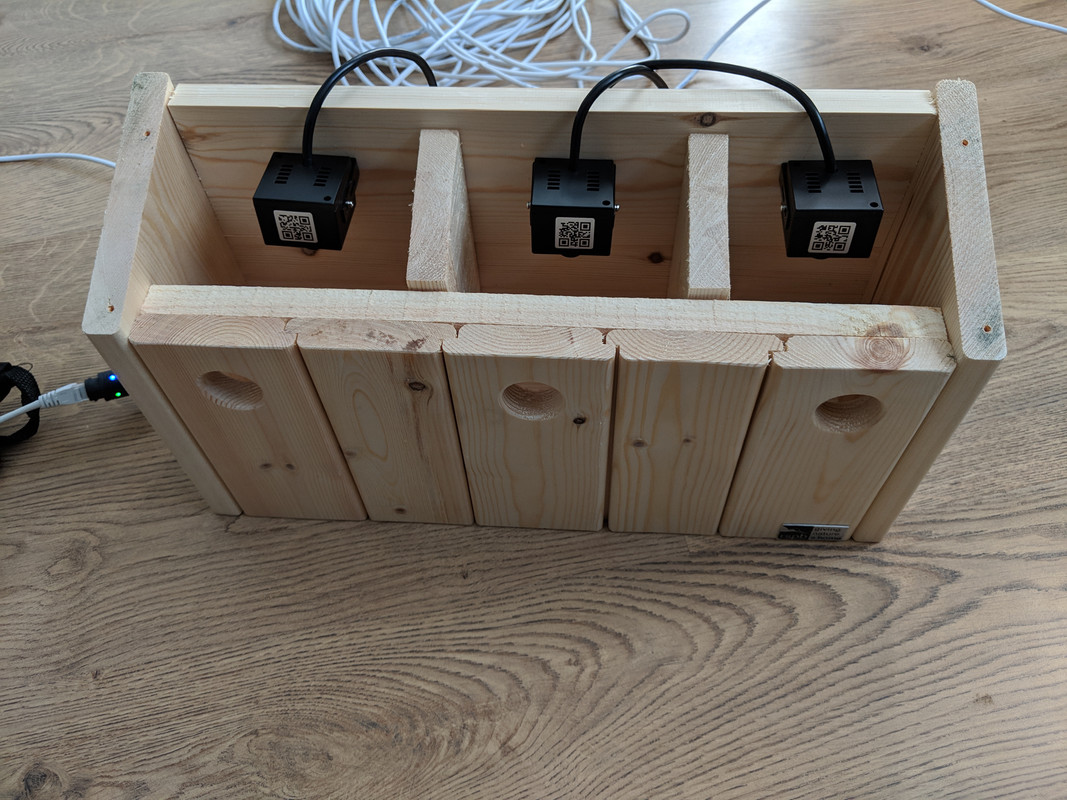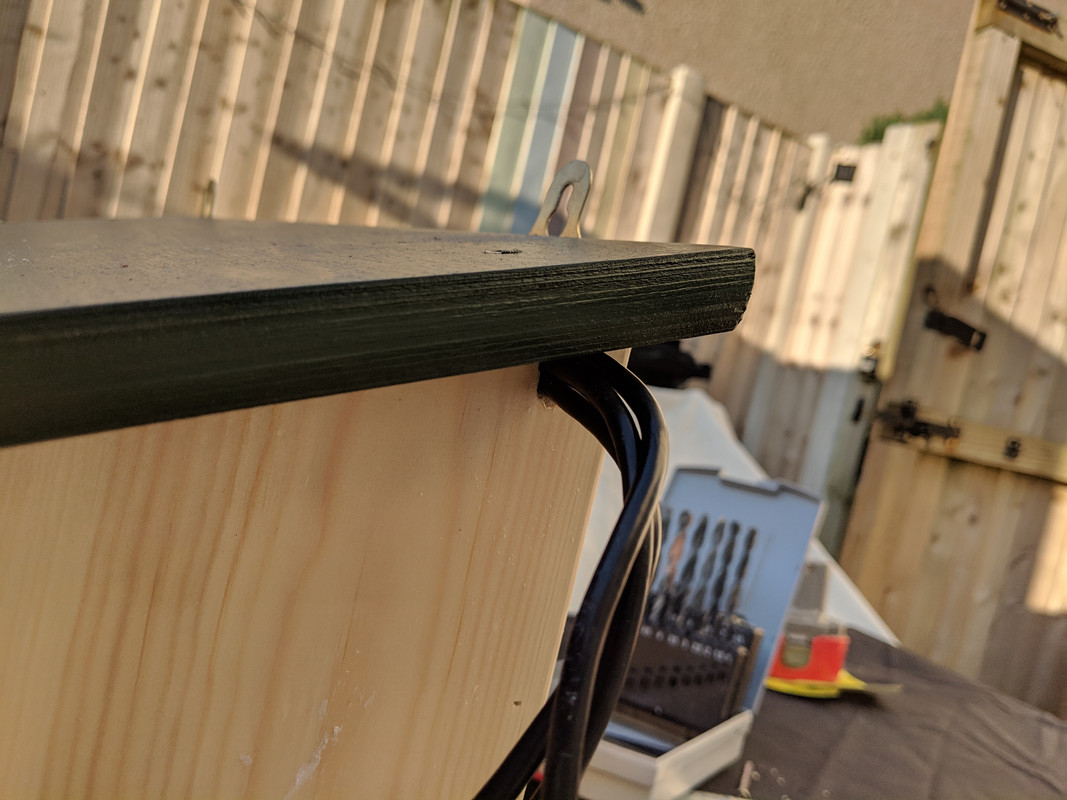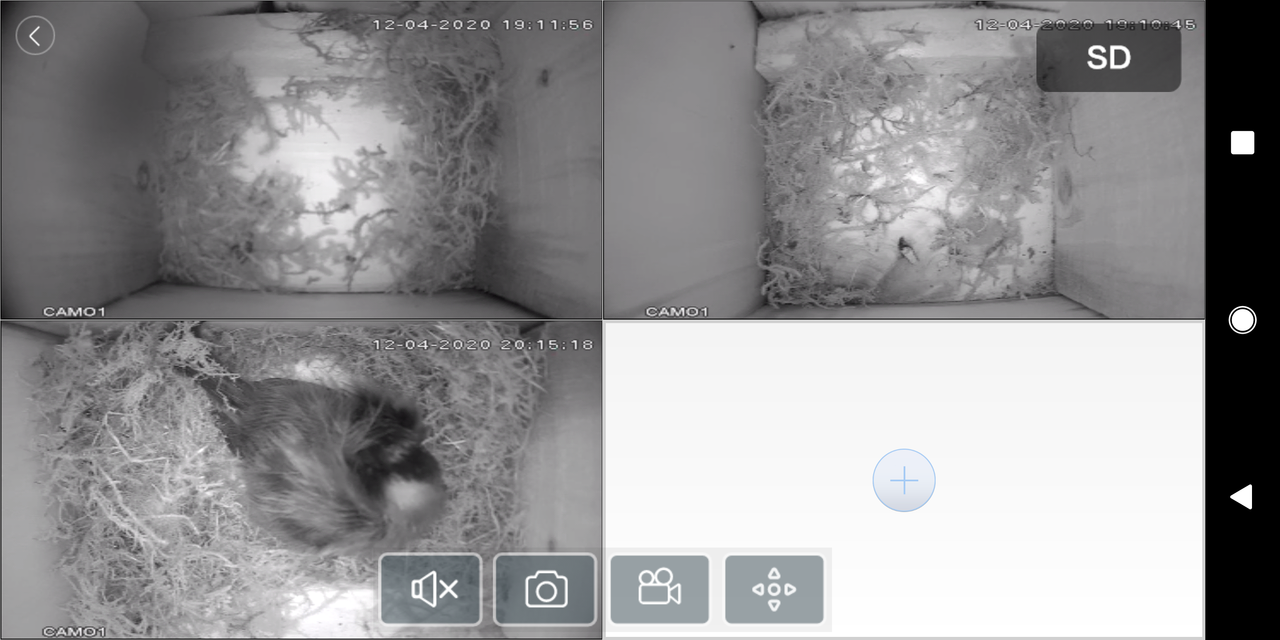Hi,
I'm not sure how much, if any, interest there will be in this.
I have three bird boxes in my back garden with cameras inside.
Although its early days it would appear that a mating pair of bluetits are starting to move in for the breeding season.
I've put up a live stream for now its just an experiment really. If there is interest then I will make arrangements to keep it up longer term.
Live Stream Link: https://bird-box.ml/
Update: Scruffy has laid 7 eggs - so far 4 chicks have hatched.
All being well the remainder will hopefully hatch between Tuesday and Thursday this week.
Previous Streams:
Playlist: https://www.youtube.com/playlist?list=PLFN1eR3Fpv7lQbnmBVB2F2ZpC-uPlojjP
Here are some recent stills: (click for large)
We had a lot of visits over the winter and in early spring where the bluetits would inspect the box for strength by pecking at all of its surfaces.
We had a few Greattits but overwhelmingly Bluetits.
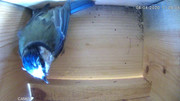
It started to become obvious that the same bird was returning a lot.
We nicknamed her "Scruffy" because of her distinct appearance

The male calls the female in to approve the box
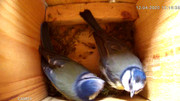
The male has occasionally been bringing insects and caterpillars to feed the female
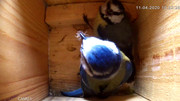
The female starting to build a nest in one of my boxes
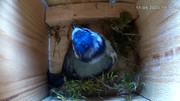
Change of plan - She's chucking it all out again
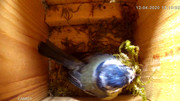
Now she has settled on one of my other boxes - a significantly bigger one - for now at least
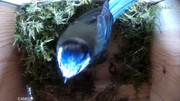
The female builds the nest largely alone while the male stands guard over the territory.
She is building in the left box while he uses the right box as a place to hang out

The female is now sleeping (roosting) in the box every night

Here they are calling to each other from their separate boxes
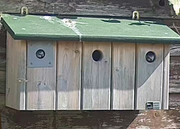
She is starting to establish the nest with moss

Now shes bringing in a layer of straw to go on top of the moss
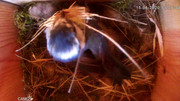
She is using the straw to wave a bit of structure and shape in to the nest

Now shes bringing in sheep's wool and bird feathers to make a soft lining
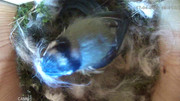
You can see the soft surface here
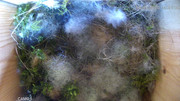
You can see here just how much material she can carry in
Relative to her size this is a big pile of moss
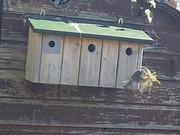
She is still coming in to roost every night from sunset until sunrise
She is spending most of the daylight hours outside now as the nest is mostly built.
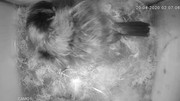
The nest has remained largely static over the past two days.
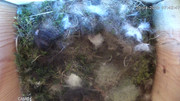
Here she is having laid her first egg

And then a second, she lays one a day now for the next week or so
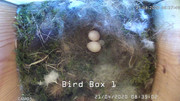
Actually she took a few days off and here is the third egg a few days later
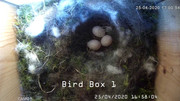
The male popped in to the nest for a look at the eggs which was interesting. She hasn't let him in very often up to now.
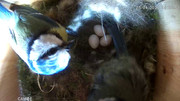
Day 15 - egg number 4
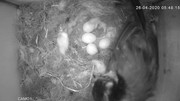
Fifth egg this morning

Male visiting to feed her some peanut butter
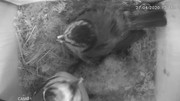
Egg number six
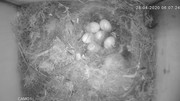
Male is visiting regularly now
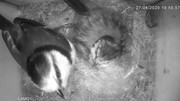
Number seven

No eggs for two days now so I think we are done at 7

She has now begun to incubate the eggs
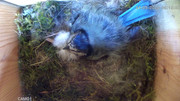
Regularly Rotating them underneath her for even warmth
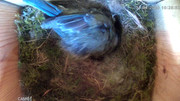
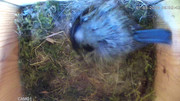

And the male is still doing his part bringing her regular food supplies so that she can remain on the eggs
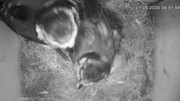
First chick hatched this evening

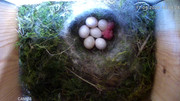
Second chick arrived the following morning
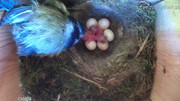
Mothers will eat the egg shells to replace lost calcium during egg laying
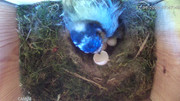
Third chick hatched just a few hours later
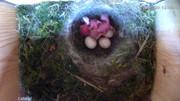
Today we woke up to a fourth chick
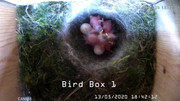
Four chicks doing well.
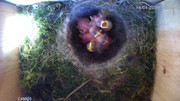
Hatching window closes tonight so unlikely that the remaining three will hatch at this point.
Some Quick Facts
Growth Stages of the Blue Tit

I'm not sure how much, if any, interest there will be in this.
I have three bird boxes in my back garden with cameras inside.
Although its early days it would appear that a mating pair of bluetits are starting to move in for the breeding season.
I've put up a live stream for now its just an experiment really. If there is interest then I will make arrangements to keep it up longer term.
Live Stream Link: https://bird-box.ml/
Update: Scruffy has laid 7 eggs - so far 4 chicks have hatched.
All being well the remainder will hopefully hatch between Tuesday and Thursday this week.
Previous Streams:
Playlist: https://www.youtube.com/playlist?list=PLFN1eR3Fpv7lQbnmBVB2F2ZpC-uPlojjP
- 12th April 2020 - Day 1 - Nest Building - Part 1 of 1 -
- 13th April 2020 - Day 2 - Nest Building - Part 1 of 2 -
- 13th April 2020 - Day 2 - Nest Building - Part 2 of 2 -
- 14th April 2020 - Day 3 - Nest Building - Part 1 of 2 -
- 14th April 2020 - Day 3 - Nest Building - Part 2 of 2 -
- 15th April 2020 - Day 4 - Nest Building - Part 1 of 2 -
- 15th April 2020 - Day 4 - Nest Building - Part 2 of 2 -
- 16th April 2020 - Day 5 - Nest Building - Part 1 of 4 -
- 16th April 2020 - Day 5 - Nest Building - Part 2 of 4 -
- 16th April 2020 - Day 5 - Nest Building - Part 3 of 4 -
- 16th April 2020 - Day 5 - Nest Building - Part 4 of 4 - https://youtu.be/-hCMCCqBvy8
- 17th April 2020 - Day 6 - Nest Building - Part 1 of 4 - https://youtu.be/Yout3z0TmPE
- 17th April 2020 - Day 6 - Nest Building - Part 2 of 4 - https://youtu.be/uoMUZcdvvNk
- 17th April 2020 - Day 6 - Nest Building - Part 3 of 4 - https://youtu.be/8vSkNZnpiMw
- 17th April 2020 - Day 6 - Nest Building - Part 4 of 4 - https://youtu.be/sz96kT2Vns8
- 18th April 2020 - Day 7 - Nest Building - Part 1 of 1 - https://youtu.be/neEZeg9Bu-I
- 19th April 2020 - Day 8 - Nest Building - Part 1 of 2 - https://youtu.be/oU6shcfJWVU
- 19th April 2020 - Day 8 - Nest Building - Part 2 of 2 - https://youtu.be/9LZw-eOjS2U
- 20th April 2020 - Day 9 - Egg Laying - Part 1 of 2 - https://youtu.be/uub3PgalIsk
- 20th April 2020 - Day 9 - Egg Laying - Part 2 of 2 - https://youtu.be/GMd6ifwk9p0
- 21st April 2020 - Day 10 - Egg Laying - Part 1 of 2 - https://youtu.be/M2arbyjFsPA
- 21st April 2020 - Day 10 - Egg Laying - Part 2 of 2 - https://youtu.be/vb1D0wxUO0s
- 22nd April 2020 - Day 11 - Egg Laying - Part 1 of 2 - https://youtu.be/8LgTFjzUyjM
- 22nd April 2020 - Day 11 - Egg Laying - Part 2 of 2 - https://youtu.be/i7bL7FX029c
- 23rd April 2020 - Day 12 - Egg Laying - Part 2 of 2 - https://youtu.be/OuAzPQFtxLE
- 23rd April 2020 - Day 12 - Egg Laying - Part 1 of 2 - https://youtu.be/U0DP0kK8MFk
- 24th April 2020 - Day 13 - Egg Laying - Part 1 of 2 - https://youtu.be/plCnaL-N42A
- 24th April 2020 - Day 13 - Egg Laying - Part 2 of 2 - https://youtu.be/-XeAy0WtjSk
- 25th April 2020 - Day 14 - Egg Laying - Part 1 of 2 - https://youtu.be/Z3-vB7hejOs
- 25th April 2020 - Day 14 - Egg Laying - Part 2 of 2 - https://youtu.be/yBsTVb6fJ_c
- 26th April 2020 - Day 15 - Egg Laying - Part 1 of 2 - https://youtu.be/6yRn79qbiao
- 26th April 2020 - Day 15 - Egg Laying - Part 2 of 2 - https://youtu.be/NmZbg-cx6t0
- 27th April 2020 - Day 16 - Egg Laying - Part 1 of 2 - https://youtu.be/ExKkt7gA8bQ
- 27th April 2020 - Day 16 - Egg Laying - Part 2 of 2 - https://youtu.be/fwbRt8tstdE
- 28th April 2020 - Day 17 - Egg Laying - Part 1 of 2 - https://youtu.be/mWl45U_N84w
- 28th April 2020 - Day 17 - Egg Laying - Part 2 of 2 - https://youtu.be/tIlR_VKMCrc
- 29th April 2020 - Day 18 - Incubation - Part 1 of 2 - https://youtu.be/5tqF_b78oAg
- 29th April 2020 - Day 18 - Incubation - Part 2 of 2 - https://youtu.be/nPP9jlNu6zI
- 30th April 2020 - Day 19 - Incubation - Part 1 of 2 - https://youtu.be/XXIOvK4N8mE
- 30th April 2020 - Day 19 - Incubation - Part 2 of 2 - https://youtu.be/Qo3XzpKZQx8
- 1st May 2020 - Day 20 - Incubation - Part 1 of 2 - https://youtu.be/G0Lvx91soRU
- 1st May 2020 - Day 20 - Incubation - Part 2 of 2 - https://youtu.be/02K9vg0m_1c
- 2nd May 2020 - Day 21 - Incubation - Part 1 of 2 - https://youtu.be/g48nOwePp1A
- 2nd May 2020 - Day 21 - Incubation - Part 2 of 2 - https://youtu.be/OPz9ob-sI-w
- 3rd May 2020 - Day 22 - Incubation - Part 1 of 2 - https://youtu.be/4j1bmHNac3A
- 3rd May 2020 - Day 22 - Incubation - Part 2 of 2 - https://youtu.be/_O6twcKl2PA
- 4th May 2020 - Day 23 - Incubation - Part 1 of 2 - https://youtu.be/kpmrWFhujYQ
- 4th May 2020 - Day 23 - Incubation - Part 2 of 2 - https://youtu.be/CkH1EO1ot14
- 5th May 2020 - Day 24 - Incubation - Part 1 of 2 - https://youtu.be/pJCPe9vXNfA
- 5th May 2020 - Day 24 - Incubation - Part 2 of 2 - https://youtu.be/pJCPe9vXNfA
- 6th May 2020 - Day 25 - Incubation - Part 1 of 2 - https://youtu.be/uPUOz0BPaeU
- 6th May 2020 - Day 25 - Incubation - Part 2 of 2 - https://youtu.be/0DJ7FZRzbd8
- 7th May 2020 - Day 26 - Incubation - Part 1 of 2 - https://youtu.be/vLqQIBhF08o
- 7th May 2020 - Day 26 - Incubation - Part 2 of 2 - https://youtu.be/06hO_rL13C4
- 8th May 2020 - Day 27 - Incubation - Part 1 of 2 - https://youtu.be/IbcNh1y9nDw
- 8th May 2020 - Day 27 - Incubation - Part 2 of 2 - https://youtu.be/Ljlcvv7Jx5k
- 9th May 2020 - Day 28 - Incubation - Part 1 of 3 - https://youtu.be/fKh6xu5fuc4
- 9th May 2020 - Day 28 - Incubation - Part 2 of 3 - https://youtu.be/XVcLfeBX3-s
- 9th May 2020 - Day 28 - Incubation - Part 3 of 3 - https://youtu.be/3OR_4WUsMYo
- 10th May 2020 - Day 29 - Incubation - Part 1 of 2 - https://youtu.be/aWfQ7n-5dT0
- 10th May 2020 - Day 29 - Incubation - Part 2 of 2 - https://youtu.be/tbF1vuHZCxo
- 11th May 2020 - Day 30 - Hatching - Part 1 of 2 - https://youtu.be/bmis7kz0HEE
- 11th May 2020 - Day 30 - Hatching - Part 2 of 2 - https://youtu.be/eHTqTzVwVbU
- 12th May 2020 - Day 31 - Hatching - Part 1 of 2 - https://youtu.be/bczDBBY4xyc
- 12th May 2020 - Day 31 - Hatching - Part 2 of 2 - https://youtu.be/cMzFQJ1dIss
Here are some recent stills: (click for large)
We had a lot of visits over the winter and in early spring where the bluetits would inspect the box for strength by pecking at all of its surfaces.
We had a few Greattits but overwhelmingly Bluetits.

It started to become obvious that the same bird was returning a lot.
We nicknamed her "Scruffy" because of her distinct appearance

The male calls the female in to approve the box

The male has occasionally been bringing insects and caterpillars to feed the female

The female starting to build a nest in one of my boxes

Change of plan - She's chucking it all out again

Now she has settled on one of my other boxes - a significantly bigger one - for now at least

The female builds the nest largely alone while the male stands guard over the territory.
She is building in the left box while he uses the right box as a place to hang out

The female is now sleeping (roosting) in the box every night

Here they are calling to each other from their separate boxes

She is starting to establish the nest with moss

Now shes bringing in a layer of straw to go on top of the moss

She is using the straw to wave a bit of structure and shape in to the nest

Now shes bringing in sheep's wool and bird feathers to make a soft lining

You can see the soft surface here

You can see here just how much material she can carry in
Relative to her size this is a big pile of moss

She is still coming in to roost every night from sunset until sunrise
She is spending most of the daylight hours outside now as the nest is mostly built.

The nest has remained largely static over the past two days.

Here she is having laid her first egg

And then a second, she lays one a day now for the next week or so

Actually she took a few days off and here is the third egg a few days later

The male popped in to the nest for a look at the eggs which was interesting. She hasn't let him in very often up to now.

Day 15 - egg number 4

Fifth egg this morning

Male visiting to feed her some peanut butter

Egg number six

Male is visiting regularly now

Number seven

No eggs for two days now so I think we are done at 7

She has now begun to incubate the eggs

Regularly Rotating them underneath her for even warmth



And the male is still doing his part bringing her regular food supplies so that she can remain on the eggs

First chick hatched this evening


Second chick arrived the following morning

Mothers will eat the egg shells to replace lost calcium during egg laying

Third chick hatched just a few hours later

Today we woke up to a fourth chick

Four chicks doing well.

Hatching window closes tonight so unlikely that the remaining three will hatch at this point.
Some Quick Facts
- Bluetits select a nest site in late March
- Females build the nest mostly by themselves from late March or early April
- Males stand guard and ward off other bluetits
- Males will bring food for the female
- Egg laying starts in mid to late April
- Female lays one egg per day at dawn
- Average clutch is 8-10 eggs
- Incubation lasts around 14 days
- Female and male both feed the chicks
- Average brood of chicks will consume 10,000 caterpillars before fledging the nest
- Bluetits fledge between 18 and 20 days after birth
https://www.bto.org/understanding-birds/articles/blue-tit-diary said:February
Blue **** start searching for a safe, warm site to start building their nest. The location is important as they require a clear flight path to the nest's entrance hole and the site must be relatively inaccessible to predators. Finding the perfect partner is also a top priority at this time.
March
Birds need to be in prime condition at the start of the breeding season. Placing bird food in the garden, particularly suet, peanuts and black sunflower seeds, provides a valuable source of nutrients and energy which can be used by females to produce eggs and keeps both parents in good condition so that they are able to supply enough food for their chicks.
The female Blue Tit builds the nest alone with little or no help from the male.
April
The female Blue Tit builds the nest alone with little or no help from the male. She takes moss will from garden lawns and forms it into a cup. The nest is complete when it is lined with soft feathers, fur or wool. Blue **** can build a nest in a few days, but generally it takes them between one and two weeks.
Early May
This is an exhausting time for the female. She lays one egg a day, usually first thing in the morning. Blue **** have one of the largest clutch sizes of all birds - up to 16 eggs! However, the majority of clutches contain 8-12 eggs.
Mid-May
The female plucks feathers from her abdomen to create a bare patch with a good supply of blood vessels (called a ‘brood patch’) which helps her to keep the eggs warm as she incubates them. She starts incubating the clutch a day before it is complete and will sit on the eggs for about two weeks until they are ready to hatch. During this time, if she made a good choice of mate, the male will bring her some food, but she will still need to leave the box regularly during the day to feed.
Late May
The chicks hatch naked and blind; as they are so vulnerable at this time the female will frequently sit on them to keep them warm. If the weather is particularly cold and wet finding enough caterpillars to help them grow can prove difficult. Trends show that on average spring is arriving earlier due to a changing climate and in turn trees' leaves open earlier, providing food for caterpillars earlier, so that they in turn peak in abundance earlier in the year than previously. Blue **** have started to breed earlier too, but their shift has not kept pace with that of the peak abundance of caterpillars. BTO research is investigating the implications of this 'phenological mismatch' for Blue **** and other species.
End of May
Feeding chicks takes its toll on the parents as they flit in and out of the nest box with juicy fat caterpillars. Each chick can eat 100 caterpillars a day, so to feed a brood of ten, adults need to find as many as 1,000 caterpillars a day. Adults also need to remove the chicks faecal sacks to keep the nest clean. By now the chicks’ feathers are well-developed and they are starting to look like they might be capable of flying.
Early June
When the chicks are ready to fledge, the parents will call from outside the box, urging them to come out. One by one each chick will poke its head out and make their first tentative flight (usually badly) to the nearest available perch. Blue Tit chicks typically fledge when they are 18-21 days old.
June and July
Fledglings stay with their parents who continue to feed them for a few weeks after they have fledged. This is a dangerous time for young birds. They need to learn how to find food and avoid predators quickly if they are going to survive. If available, they may take advantage of peanuts and sunflower seeds provided in gardens to build up their strength.
Growth Stages of the Blue Tit

Last edited:




